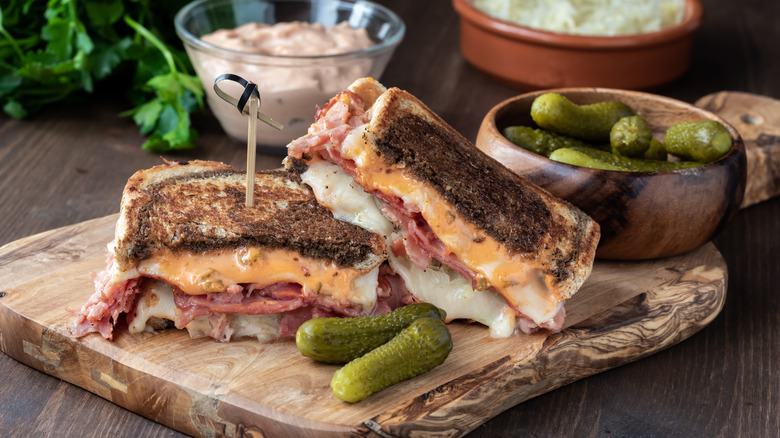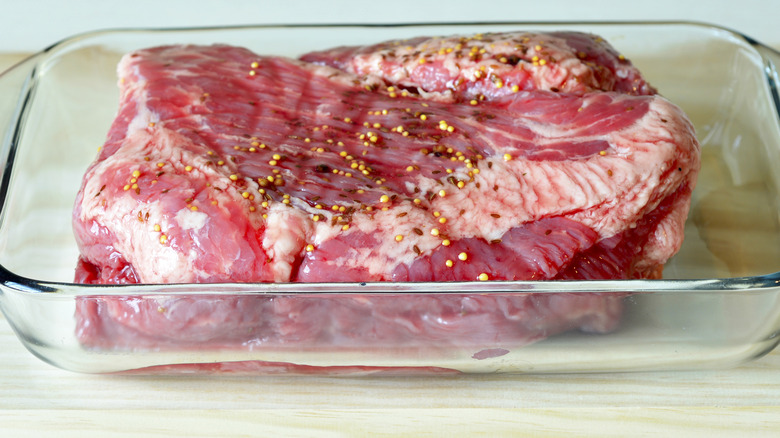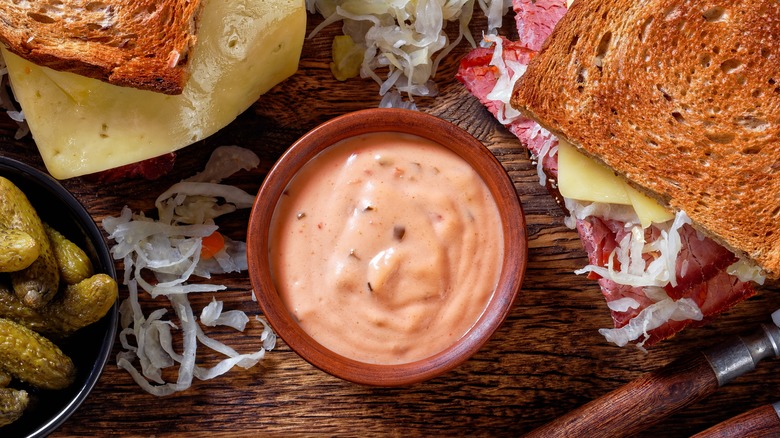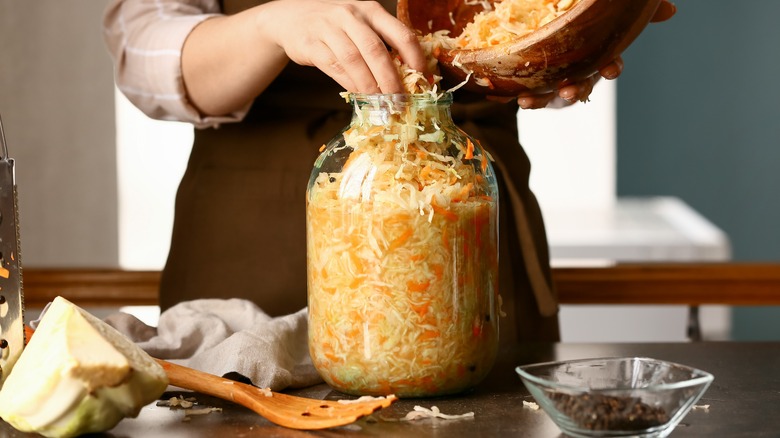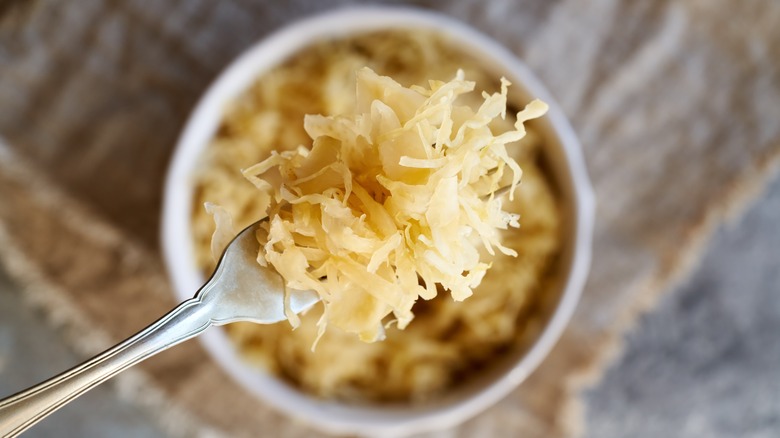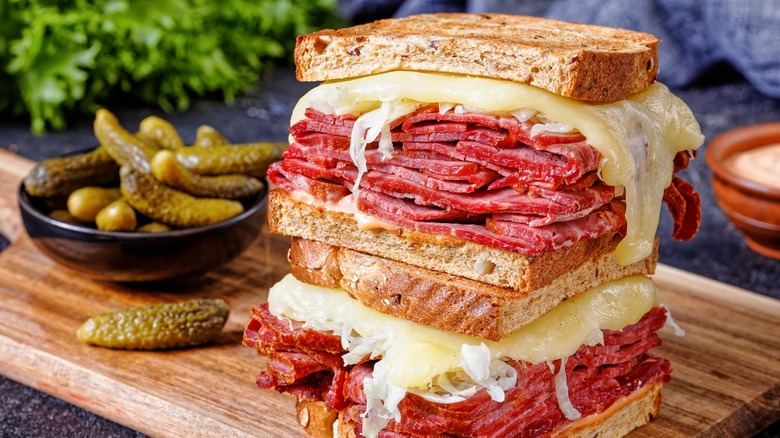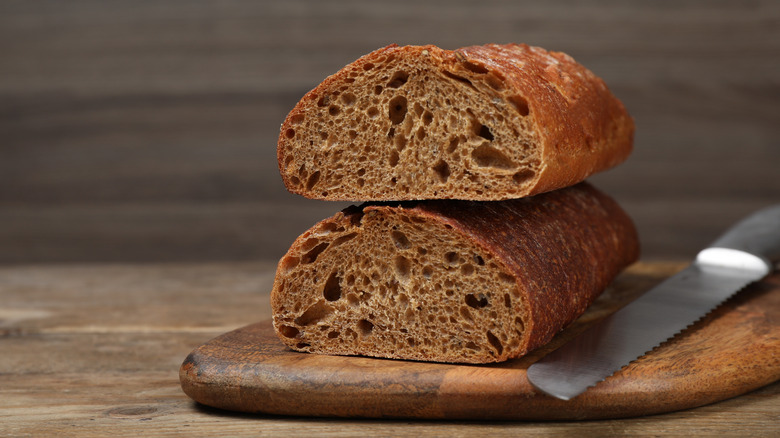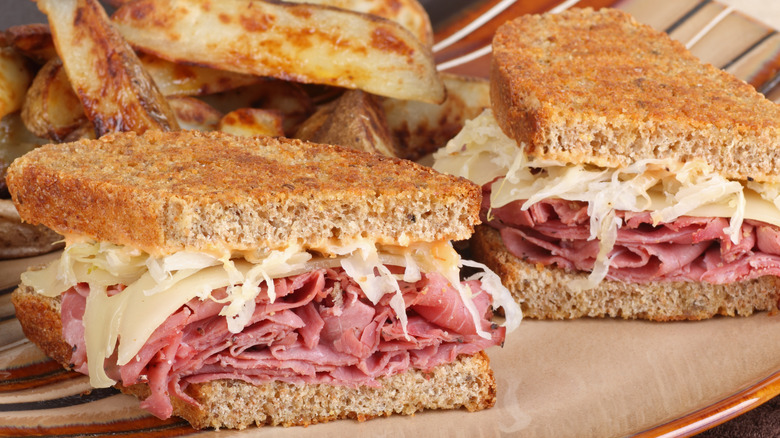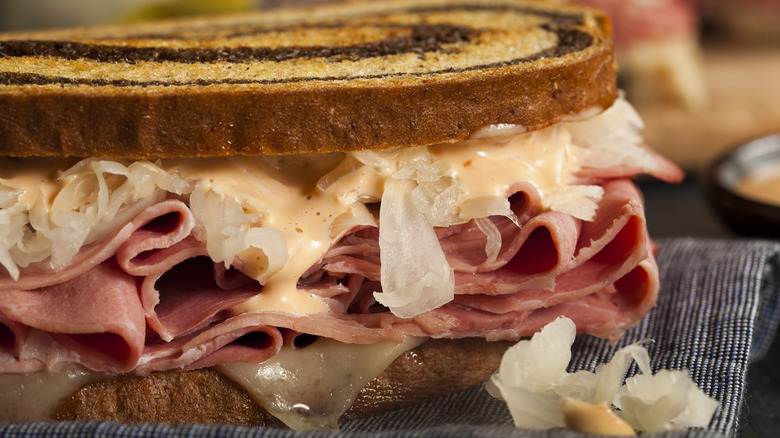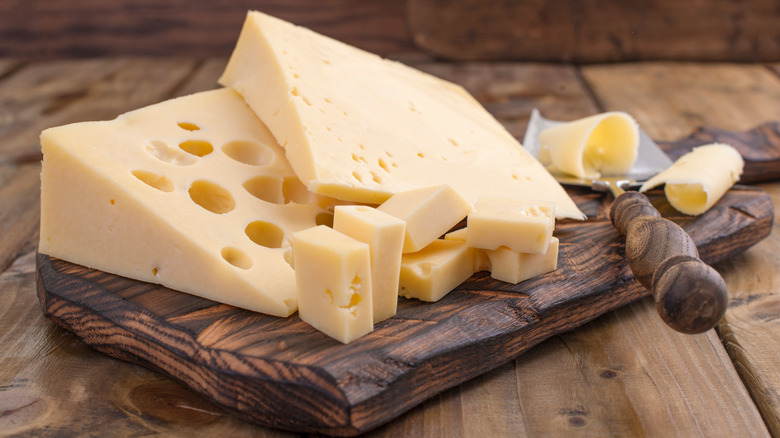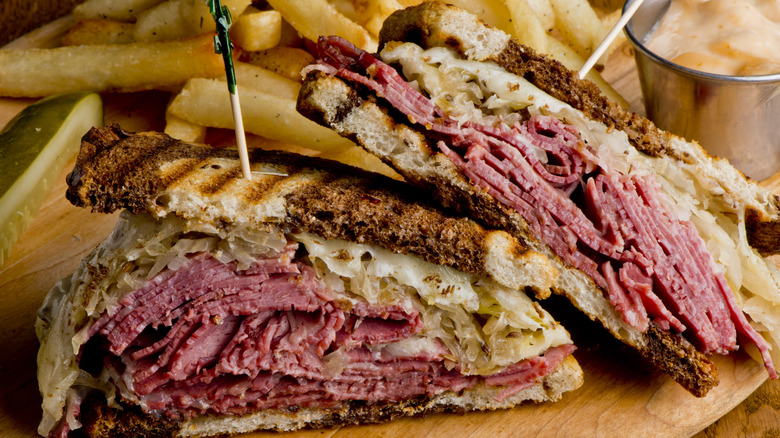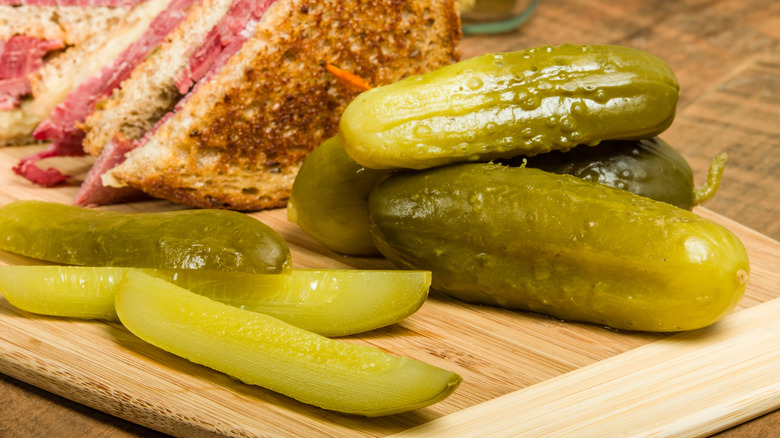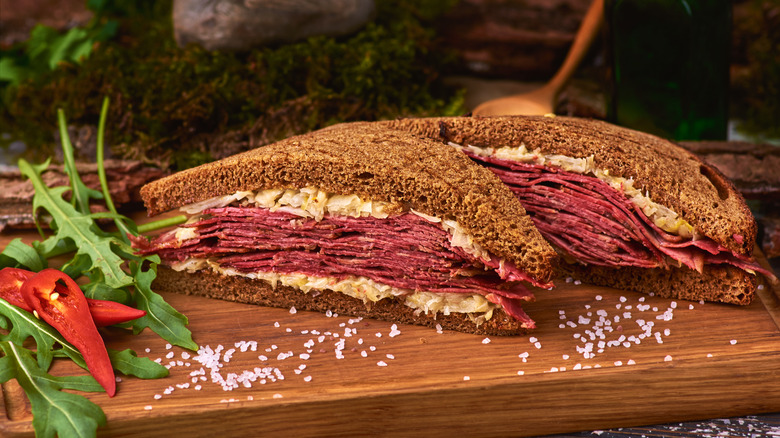Tips On How To Elevate The Classic Reuben Sandwich
Who can resist a Reuben? One of the world's iconic sandwiches, this deli classic was reportedly invented in Nebraska in the 1930s, according to Saveur, though this origin is contested (via Mashed). It consists of five basic ingredients: corned beef, sauerkraut, Russian dressing, and Swiss cheese on rye bread, and is traditionally served with a pickle on the side. The original Reuben was pressed in the style of a panini, so that all the ingredients meld together into a gooey, meaty, spicy, and savory work of sandwich art.
Today you'll find all kinds of sandwiches calling themselves Reubens, using varying ingredients and riffing on the classic recipe. Many have Thousand Island dressing in place of Russian, some add mustard, while others throw pickles on the sandwich instead of serving them as an accompaniment. Most aren't pressed like the original, but stacked high, toasted or griddled, or served open-faced. There are countless variations, made with different meats, breads, and cheeses, including some vegan and vegetarian alternatives. If you're looking to perfect your own Reuben crafting skills, sticking to the classic with perhaps a few tweaks here and there, look no further than these helpful tips. You'll have an elevated sandwich to rival the top deli offerings right from your own kitchen.
Make your own corned beef
Arguably the most important element of the Reuben sandwich is the corned beef. It's the main filling upon which all of the other flavors are built. If you use subpar corned beef, it'll be a tough challenge to create a top quality sandwich, so make sure you are using the best beef you can get your hands on. For the ultimate quality control over this critical ingredient, serious Reuben-makers should consider making the corned beef from scratch. It may seem like a daunting task, but it's really a straightforward, if time-consuming, process.
Despite its name, corned beef isn't made with corn — the word was used to refer to the kernels of spice and salt used to flavor and cure the meat, according to New England Today. Traditional corned beef is made from brisket, which is either dry cured or wet brined, and flavored with a combination of spices that include juniper, mustard, allspice, cloves, peppercorns, and bay leaf. Specialty curing salt, otherwise known as pink salt, can also be used, which will help the meat retain its bright color. A long cure is needed for the seasonings to fully penetrate the meat, ranging anywhere from a few days to a week depending on the size of the brisket. After that, the beef is braised at a low temperature until tender, then it's ready to be sliced and piled onto your sandwich.
Make your own dressing
While Thousand Island dressing may be more common these days, Russian dressing was the spread of choice for the traditional Reuben, as The Washington Post discusses. Thousand Island has a somewhat sweeter, creamier profile compared to the bolder Russian condiment, which contains sharper ingredients to give it more of a bite. Whichever style you prefer on your sandwich, one of the best ways to upgrade and customize your Reuben is to make the dressing yourself, rather than relying on a storebought version. This way, you can control the spice level, the flavor profile, and ensure that it's as fresh as can be.
For both dressings, you'll want to start with a base of mayonnaise and ketchup. Sweet pickle relish is an essential element in Thousand Island, though if you're going for classic Russian, you'll want to make sure you include chili sauce and horseradish to give it its signature intensity. Garlic, onion, vinegar, lemon juice, salt, and pepper are some other ingredients you'll want to include according to taste. Both styles complement the Reuben in their own way — mellow Thousand Island balances out the other sandwich elements' strong flavors, while Russian dressing punches them up and cuts through the richness. Try both to see which you prefer.
Make your own sauerkraut
Fermenting foods at home can seem intimidating, but much like making your own corned beef, the process is fairly simple, as long as you have plenty of time and are able to plan ahead. Making your own sauerkraut can be fun and rewarding, and it's easy to customize using your own preferred ingredients. There are plenty of great high-quality sauerkrauts on the market, but if you want complete control over this essential Reuben ingredient, homemade is the way to go.
Sauerkraut consists of two things: cabbage and salt. Spices are optional, and often include similar spices to those used in corned beef, such as juniper berry and mustard seed. Dill and caraway seeds are typical as well. The magic of sauerkraut comes from the fermentation process, which takes care and precision to complete properly. According to this guide from the University of Minnesota, the key is to get the ratio of salt to cabbage right. Three tablespoons of salt are needed for every five pounds of cabbage, per the guide. Use fresh, thoroughly cleaned cabbage, shred it yourself, mix it with salt, and pack it tightly into a proper food-safe container, with a weight on top of the surface to keep the mixture safe from air contact, which can spoil the batch. After a few weeks or months of fermentation, the cabbage will be transformed into sauerkraut — salty, tangy, sour, and ready to go for your Reuben.
Drain the sauerkraut to keep the sandwich from getting soggy
There are few things as disappointing as a soggy sandwich. To spend all that time and energy crafting each element to perfection, only to have a limp, formless lump on your hands is a tragedy, but, luckily, it's an avoidable one. The Reuben can be tricky in this regard, because in addition to the Russian dressing, the sauerkraut is another element that adds moisture to the filling. Both of these ingredients together, if not treated carefully, can become watery and soak through the bread.
Whether you've purchased sauerkraut or made your own, you'll want to ensure it's not too wet when you add it to your Reuben. It can be drained easily using a strainer, colander, or even thrown in a salad spinner. If you don't have one of these pieces of equipment, pressing it between paper towels will do just fine in a pinch. Of course, you don't want it too dry either, so don't leave your kraut sitting outside of its brine for too long, or it can lose its fresh and snappy texture.
Stack the ingredients high
Bread is, of course, a crucial element of sandwiches. One might even say its the defining ingredient of a sandwich. However, it shouldn't be the star of the show. It's what's between those two slices that make a sandwich unique and craveable, so why skimp on the fillings? With all sandwiches, including Reubens, getting the bread to filling ratio is important for optimum sandwich enjoyment. And if you're really going for a top-tier Reuben, you want the centerpeice ingredients to take full stage.
Piling the meat, cheese, and saurkraut high is particularly important if you're pressing the sandwich. This will compact the inner layers, and you don't want to end up with strata between your bread. Make sure you're heaping those ingredients on generously to account for the pressure that will squeeze them down. If you're toasting or griddling your Reuben, this isn't as much of a concern. But doesn't a hefty, meaty, lavishly layered sandwich seem more appealing? The flavors in a Reuben are bold and powerful, and deserve better than to be lost in the bread of a dainty sandwich.
Use the best, freshest rye bread you can find
No matter which origin story you believe, the old recipes all agree that rye is the bread of choice for a Reuben. But what kind of rye remains up for debate, and the category of rye bread is vast. As rye expert and author Stanley Ginsberg told The Nosher, despite the bread's common association with caraway, not all styles of rye contain the aromatic seeds. There are different styles of rye loaves from around the world that encompass all kinds of unique flavor profiles and textures, so when a Reuben recipe simply calls for rye bread, you're faced with a big choice.
As long as the bread is made with rye grains, it's fair game for a Reuben. After that it's all about personal preference. Light rye will be the mellowest option, while dark rye will give you more flavor, and if you can't decide, there's always marble rye, which gives you the best of both worlds. Pumpernickel is a type of rye bread too, and is a good option if you prefer a coarser texture. No matter which style of rye you choose, the most important factor is to make sure the bread is fresh. If you're a skilled home baker, making your own is the best way to ensure your bread's quality. Otherwise, find a nearby bakery and ask for their freshest rye loaf. Your Reuben will thank you for it.
Don't slice the bread too thick or too thin
A perfect sandwich is all about ratios, and one make-or-break element is the thickness of the bread. With a Reuben, you want your fillings to be generous, so you'll need your bread slices to be thick enough to handle the guts of the sandwich without falling apart. However, you don't want them to be so massive that they take over all of the other flavors and textures and leave you chewing dry bread at the end of every bite.
Err on the thick side if you're pressing your sandwich to account for compaction. Otherwise, try to go as thin as you can so that the bread keeps its shape and firmness but doesn't overpower everything else. This can take some trial and error, and will vary based on how plentiful your fillings are, but you'll know when you've found the sweet spot. Keeping all of the meaty, oozy fillings firmly between the slices is crucial to the success of your Reuben — otherwise you'll have a droopy, sloppy mess on your hands.
Slice the corned beef thin
Most home cooks don't have access to a professional deli slicer, which makes carving whole hunks of meat into sandwich-ready slices a challenge. Thin slices, which means less than ⅛ of an inch, according to meat slicer producer LEM, are ideal for sandwich making, particularly for panini-style pressed sandwiches. This width lets you stack the meat high with more stability than bigger chunks of meat, and allows the sandwich to hold together through the pressing process without the meat sliding around.
That narrow width may be tough to slice by hand, but make sure your knife is sharp and slice the corned beef as thin as you are comfortable going with. Slicing the meat against the grain helps to tenderize it, according to Salvaggio's Deli, giving the corned beef an even more supple texture. Of course, there's no judgment if you prefer your Reuben with beefy bites of meat that you can really sink your teeth into.
Opt for a high-quality Swiss cheese
A Reuben wouldn't be its melty, gooey self without the critical addition of Swiss cheese. Like rye bread, the term Swiss cheese is a vague catch-all that can refer to either cheese made in Switzerland, or the American version of Swiss cheese, which is closest in style to Emmental, according to Cheese.com. There's nothing inherently wrong with American Swiss cheese — it's nutty, mellow, and perfectly tasty on a Reuben. But if you want to make your Reuben elite, there are other cheeses to consider.
The Swiss make hundreds of cheese styles, according to Cheese Professor, with a few that are readily available and specifically suited to melting on a sandwich. Of note, all are protected products, strictly regulated by the government for quality. Real Swiss Emmentaler is a good upgrade, with more depth of flavor and pronounced nuttiness when compared to American Swiss cheese. Another option is Gruyere, particularly the younger styles, which have a texture made for melting. Finally, Appenzeller is an intense Swiss cheese that will add another layer of complexity to your Reuben.
Toast, press, or griddle the sandwich for optimum melting
Historically, the original Reuben was a pressed sandwich, with the ingredients mashed together under pressure and heat, as Saveur reports. But if you don't own a panini machine or a grill press, never fear — you can achieve the same crispy exterior and melty warm interior using plenty of different cooking methods.
Once the Reuben is fully assembled, spread the outsides of each slice of bread with a fat of your choice and place the sandwich on a hot griddle or cast iron skillet, pressing down on it with a spatula and flipping until the cheese is melted and all of the ingredients are heated through. Another way to get your Reuben toasty is to toast or grill the bread separately, heat up the corned beef and sauerkraut on their own, and then assemble everything with the dressing and cheese before popping the sandwich in the oven or toaster oven to finish the melt. The trick is to get the cheese gooey before the bread burns, so whichever method you use, always keep an eye on the sandwich while it's warming up.
Don't forget the side of pickle
The Reuben can be a rich, intense powerhouse of flavors, which means occasionally your palate may need a reset or it could become fatigued or overwhelmed. Enter the pickle — a deli staple. The pickle is not just served on the side for looks, its zingy, zippy acidity can refresh your taste buds, cutting through the fat and richness of the sandwich so you're ready to go back for more.
You can add pickles to the sandwich if you wish, which will admittedly add a nice crunch and tang, but that's veering a bit off the pure classic Reuben highway. The type or shape of pickle is a matter of personal taste. A whole pickle or spear will give you the most satisfying crisp bite, but a pile of pickle chips will do the trick, too. Kosher, dill, sour, and half-sour are some classic deli styles, or if you want to go a different route and contrast the bold spicy, savory notes of the Reuben, bread and butter, or sweet pickles can offer a nice change of pace.
If you're making the whole Reuben from scratch, top to bottom, making your own pickles is all part of the fun — and doesn't have to be time consuming, thanks to quick and easy pickling recipes. And if you're not a fan of traditional cucumber pickles, any vegetable will do for the same purpose, from turnips to cauliflower to peppers.
Make a variation with pastrami or Montreal smoked meat
There's no debate that the classic Reuben was made with corned beef. But over the years, other meats have been subbed in with generally great results. While Reuben purists may turn their noses up at these interlopers, for adventurous sandwich fans it's worth exploring what these different meats bring to the Reuben — you may find you prefer one or the other over corned beef.
Pastrami is a frequent Reuben guest star, so much so that it's got a sister sandwich with its own name: the Rachel. This riff on the Reuben includes pastrami instead of corned beef and swaps out the sauerkraut for milder coleslaw, per STL Jewish Light. These changes are definitely enough to warrant a new sandwich with a unique flavor profile, but you can also keep the sauerkraut and just switch the meats to stay closer to the Reuben's roots.
The meat is made in a similar method as corned beef, but comes from a leaner cut of brisket. It's also more generously spiced, and the meat is smoked to add another layer of flavor and intensity. Montreal smoked meat is another corned beef alternative. It goes through a similar lengthy brining process, and as the name implies, it's smoked like pastrami. It's made from the whole brisket, like corned beef, so it's richer and fattier than pastrami. If you're feeling extra adventurous, try a combination of these meats to make the ultimate riff on a Reuben.
